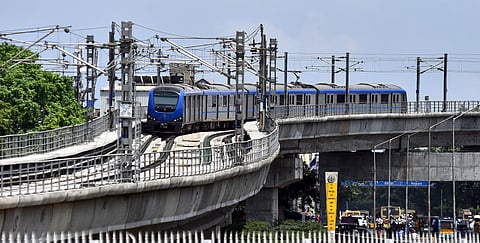

CHENNAI: It’s not every day that you get to experience the New York subway system. Not if you are someone who has spent all her life in one city. That six subway lines crossed paths was inconceivable, after having dealt with just two lines of the local railways in Chennai. I was truly lost when I was handed a map of the subway system.
Multicoloured lines crisscrossing through the city, transit lines marked by alphabets, numbers or both, every major intersection outside the stations plotted for reference — it was too much information compared to the yellow sticker of railway stations pasted inside our trains. I was happy to let my cousins lead the way. While it was the New York subway that had me floored, Ravi Shankar drew inspiration from its counterparts in Europe and decided to bring a slice of it to Chennai. And voila! We get an urban transit map that offers a rundown on every railway line, including the Metro, in the city.
Many a motivation
This project was born out of the need to fill a vital gap in Chennai’s public transport system, begins Ravi. “Any public transport network should have a robust system in place to give its users information about the network plan, the transfer locations, the current delays, latest incidents, etc. Chennai Metro has an outdated, hard-to-read timetable and a map that is limited only to their network, both available only in English. The latter includes no landmarks or places of interest. The suburban railway and MRTS have neither, despite carrying about 10 times more passengers annually. The timetable problem cannot be solved by the users but the map, at least, can be improved upon greatly,” explains Ravi, a civil engineering graduate who worked with the Indian Railways for two years before moving to Germany for a Masters degree in Transport & Railway Engineering from Technische Universität München.
This is not the first time a common man has taken up the task of fixing a transit map. And that is precisely what seems to have inspired Ravi. “Several transit maps for Chennai have been made in the past, both by open source contributors and commercial websites. Most are outdated, some are inaccurate, and a majority are aesthetically unappealing. I have also gone through maps of other European cities, specifically the redesigns of existing maps. Paris is an example of a really complex network, and the official transit map doesn’t even show the Eiffel Tower! A redesign by Russian designer Constantine Konovalov gives a new perspective of the city,” he notes.
Of potential and possibilities
With backing to boot, he got started on a transit map for Chennai. Relying on data from official websites, Wikipedia and OpenStreetMap, and software like Affinity Designer and Inskscape, and a few hours daily for 10-15 days, the deed was done. Ravi’s map uses a combination of colour coding and naming schemes to identify the railway lines. Distances and angles between stops are accurate for at least 90 per cent of the map, he says. The city’s rivers and beaches serve as landmarks to anchor the entire system. Barely a week after releasing the map in Tamil, he also made it available in English.
“A good transit network map is very important for attracting people to use it. Even more so for tourists. Although the multiple modes of transit don’t have unified ticketing yet, it is important to show the network as a whole instead of singling out each mode,” he reasons.
Ravi has also made available the SVG (scalable vector graphics) file, offering a solid foundation for others to customise the map. There are endless possibilities, he points out. “Lots of things can be done now — bus routes (at least the ones that run across the metro and rail lines) could be added. A map exclusively for buses could be another extremely useful tool. This requires a lot of data, which is currently lacking on their website. Likewise, these kinds of maps can be made for other cities as well,” he details.
And this is just the start, he reminds us, pointing out that there is much to be done in the realm of public transports’ accessibility and information. “Public transport is for the public. The timetable and transit network details must be public. If Southern Railway cannot publish an accurate timetable due to Covid rules, it must publish the bare minimum services that are offered daily. MTC (Metropolitan Transport Corporation) should focus on naming or numbering all stops. Each bus stop might not have a shelter, but it must contain the name, the buses which stop there and their timetables. Finally, it should all be available in Tamil,” he lists. Perhaps, his work would inspire some railway engineer to work on these gaps.
View and download the map at github.com/rainshark/ChennaiTransitMaps